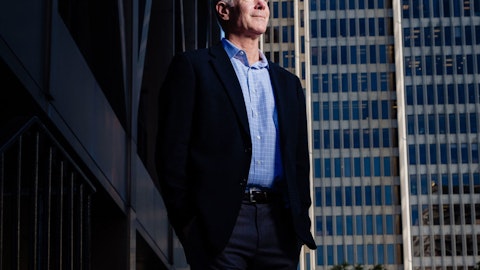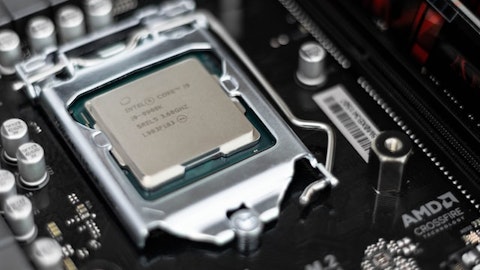Those are laptop-specific brand new audio products from us. Then — and the audio proposition, I think, is extremely strong. So what we’ve seen in benchmarking that against the competition is that our products enable you to double the output loudness, 3x the low frequency response while consuming 50% less board space, 50% less power and something like a third of the overall component count. So that’s a very compelling proposition. It’s going to take time to see people adopt all of that or parts of it and for that to proliferate down through the tiers. But I think the opportunity is very, very significant. And then — so the first milestone was really getting those audio products into the market and launched. The second is winning our first power products.
So again, that’s something where we can see an attach rate. Where that gets designed in, the attach rate can be two or three products, in some cases, conceivably more than that. But that, again — and those products, the power conversion products are fairly significant value by our standards, so kind of buck and change. So we don’t know where the — exactly like how far down through the tiers that can go yet. But again, it’s — it represents a great opportunity and getting the first design in of Power Products is a very significant milestone for us. And then the third milestone that we’re talking about here today really is that reference design launch. And that as we know, can be a real catalyst for helping design activity as we go forward.
Venk Nathamuni : Yeah. And Matt, this is Venk. Just to add to what John said, in terms of just the total size of the opportunity that we’re looking at as well as the pricing question that you asked. So clearly, we’re starting out with addressing the high end of the laptop space. And as John just alluded to, there’s a range of possibilities there in terms of selling the codec and the amplifiers and then power eventually. And then just from a pricing standpoint, I’d say we expect this to be in line or above our corporate average gross margins. So that’s our model long term, and that’s what we’re working towards achieving.
Matt Ramsay : Got it. Thank you both for all the detail there. Don’t worry, we won’t get over our skis of modeling. I’m just trying to sort of calibrate my expectations over the longer term. As my follow-up question, it’s a year where, as you sort of, I guess, reemphasize that you’re going to be shipping a new codec on 22-nanometer and new boosted amplifiers, both later this year. And I guess I just wanted to ask, is there going to be anything — I mean, units aside, which obviously you won’t want to predict, but anything different in the revenue ramp cadence or timing given you have new products shipping in on both the codec and the amplifier side? Just all else equal on units, would you expect a different shape to the year because both of those products would be new into SKUs? Thanks.
Venk Nathamuni : Yeah, Matt, I’ll address that. No, I think you correctly identified the increased content that we had alluded to in prior quarters in terms of what we expect in our fiscal ’25. And I think in terms of just the timing of those ramps, the typical pattern with our customers being to ramp those products in right around the middle of the year, plus or minus. So we don’t see anything that’s fundamentally changed in terms of the timing of those ramps. And in terms of the overall content, we did talk about those four components that will have a newer generation compared to the prior phone model. So we’re pretty excited about the fact that we’re reducing the next generation of the codec and three instant stations for the next generation of the amplifier. And that’s what we expect will drive our performance in fiscal ‘25.
Operator: Your next question comes from the line of Thomas O’Malley with Barclays. Please go ahead.
Thomas O’Malley : Hey, good evening, guys. And thanks for taking the question. John, in the script, you talked about two custom components for an augmented reality product. Could you talk about what sort of products you would be shipping into that genre? And then potentially how you see that portfolio scaling? You’re seeing small unit volumes to start there over the past couple of years, but that could obviously be a lot larger in the coming years. I just want to understand where you guys best address that market.
John Forsyth : Yeah. Thanks, Tom. I think we’re excited about that category without really having anything significant in our model for it for now, as you alluded to. If you look back over the last three or four years, I think, perhaps, even slightly longer than that since the category has been emerging VR and AR. We’ve got a very good track record of getting sockets in there, typically with off-the-shelf silicon and typically focused on audio. In this case, the components that I was alluding to in my opening remarks are actually in the HPMS category. I’m not going to be more specific about what they’re doing from that, but again, that’s a positive for us, I would say, as it demonstrates that we have both HPMS and audio relevant capabilities for that category of device.
And I think that makes a lot of sense because we know that physical size, physical weight and power efficiency are going to be incredibly important when it comes to anything that you have to wear on your head for extended periods. So we’re excited long term, and we’ll kind of continue to monitor that category as, hopefully, it accelerates.
Thomas O’Malley : Super helpful. And then switching to an entirely different topic. Just back on the other updates in the new foundry. I just wanted to be clear. So you’re talking geographical diversity, you’re talking to more power products there. Is this a foundry that’s based in the U.S. or just a foundry that has a facility in the U.S.? Just trying to understand better the landscape. Thank you.



